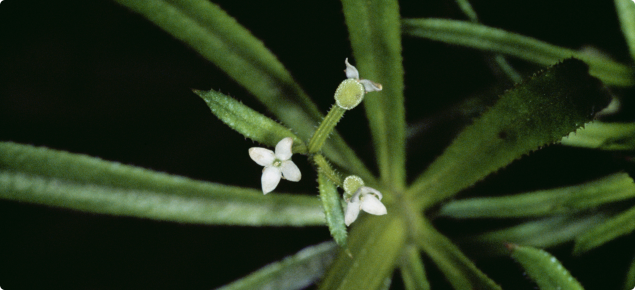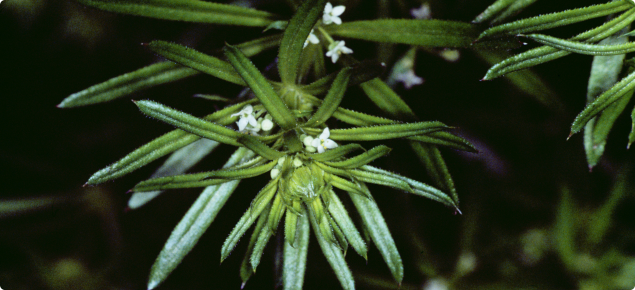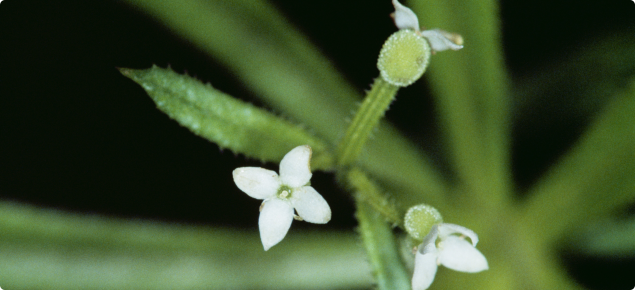Three-horned bedstraw
Three-horned bedstraw (Galium tricornutum) is an annual weed that poses a significant threat to Western Australia’s grains industry.
It is a competitive climbing plant that forms dense masses of tangled stems in crops, along fencelines and in wasteland. Interstate experience shows that heavy infestations of the weed can halve crop yields.
Bedstraw is difficult to control in canola and pulse crops, and the size of the seed makes it difficult to separate from canola during seed cleaning.
If the weed were to become widespread and fully established in Western Australia, it would impact the state’s grains industry as a result of extra weed control costs and foregone yield.
A recent economic assessment of the impact of bedstraw estimated that the damage caused by uncontrolled bedstraw to WA agriculture over a 30-year period would average $1.5 million a year (Cook 2014).
Bedstraw infestations have been found on four separate properties in the Western Australian agricultural area since 2001. It has been eradicated from two of these.
Bedstraw Eradication Program
Key program achievements
· Two properties have been released from quarantine, one in 2011 and one in 2014, halving the number of bedstraw-infested properties.
· Greatly reduced numbers and densities of bedstraw plants on the two properties operating under approved programs.
· No new areas of bedstraw infestations have been found within the infested properties or elsewhere in the State.
· Seed image analysis detected a single bedstraw seed in a canola sample in early 2014, but its source remains unknown.
· Bedstraw surveillance and eradication plans drafted.
About the program
The current Bedstraw Eradication Program, funded by the Grains, Seeds and Hay IFS, began in 2010. Before this date the Department of Agriculture and Food, Western Australia (DAFWA) funded bedstraw eradication activities. The Grains, Seeds and Hay Industry Management Committee contracts DAFWA to deliver the program, with the aim of protecting the state’s grains, seeds and hay industries by preventing the establishment of bedstraw in Western Australia.
At the start of the IFS-funded program in 2010 there were four known properties with bedstraw infestations, with a total of around 420 hectares in quarantine. During 2013/14, eradication activities were carried out at two farms on a total of 308 hectares of quarantined paddocks.
In conjunction with the landholders with the two remaining infestations, the program developed and implemented bedstraw management plans that are tailored to each property. These plans, known as ‘Approved Programs’, specify the management practices required on the quarantined areas in order to achieve eradication of bedstraw. The Approved Programs are updated each year.
In addition to the eradication program, a surveillance program has been carried out to determine whether any other bedstraw infestations occur in the cropping regions. This involves image analyses of grain samples from CBH terminals. The image analysis technique allows large numbers of samples to be screened in a relatively short period of time.
The samples are loaded onto a conveyor belt that carries the grain past a video camera. The images taken by the camera are analysed by software that enables detection of any bedstraw seeds present, based on a pre-determined set of characteristics. If suspect seeds are detected, the sample is separated from the bulk and inspected visually.
Achievements to date
The number of bedstraw-infested properties reduced during 2013/14 when the Mt Barker property was released from quarantine in early 2014. A property in the Cranbrook Shire was released from quarantine in 2011.
No further spread has occurred within or from the two remaining infested properties. Herbicide treatments applied within the properties have prevented bedstraw seed production by destroying seedlings and mature plants. There are also encouraging signs that the soil-borne bedstraw seed bank is declining at both properties.
At one property where the worst infested paddocks contained high densities of bedstraw plants in the worst affected areas when first quarantined, only around 100 plants were found during the 2013 season throughout the 260 hectares that remain in quarantine.
In early 2014 a single bedstraw seed was detected by DAFWA’s Albany office during routine seed image analysis of CBH canola grain samples from the Katanning district. The farm and paddocks from which the canola sample originated were searched thoroughly in mid-2014 and no bedstraw plants were found – the source of this bedstraw seed remains unknown. In response to this detection, DAFWA prepared a surveillance plan that is being followed during the search for bedstraw on this farm.
DAFWA has drafted generic surveillance and eradication plans to follow when undertaking future search and eradication activities for any future detections of bedstraw in the state.
Program expenditure
As part of the approved program, each landholder contributed some of their own time and resources to eradication of the weed on their property. However, the bulk of the funding for implementing the programs was provided by industry through the industry funding scheme. In addition, where an approved program resulted in a loss in farm production, the landholder was able to make an application for compensation from the scheme.
Under the Biosecurity and Agriculture Management Industry Funding Scheme (Grains) Regulations 2010, payments of compensation may be made for direct losses resulting from actions or measures taken under an approved program.
In 2013/14, two compensation claims were received by the Industry Management Committee. The claims were assessed, with advice from the Department of Agriculture and Food and independent sources, and offers were made to the two claimants, which were subsequently accepted.
Any compensation paid is separate to the Bedstraw Eradication Program; however, compensation claims are paid from funds collected by the Industry Funding Scheme.
| Expense | Cost ($) |
| Staff expenses | 86 218 |
| Supplies and services | 70 305 |
| Total | 156 523 |
| Compensation | 131 244 |
Future
Surveillance is a key component of any weed eradication program, but on-ground searching is labour-intensive. The seed image analysis system developed at DAFWA’s Albany laboratories provides a relatively quick low-cost method of screening grain samples for the presence of bedstraw seeds (and, potentially, other contaminants).
On behalf of the Grains, Seeds and Hay Industry Management Committee, DAFWA has entered discussions with CBH about the possible use of its EyeFoss seed testing equipment to screen harvested grain samples from across the South-West for the presence of bedstraw seeds. The EyeFoss system uses the same image analysis approach as the DAFWA system and is already being used at many CBH terminals to test for a variety of seed quality and contamination characteristics. The range of tests done by the EyeFoss system could be expanded relatively simply to include to capacity to ‘recognise’ bedstraw seeds in grain samples.



